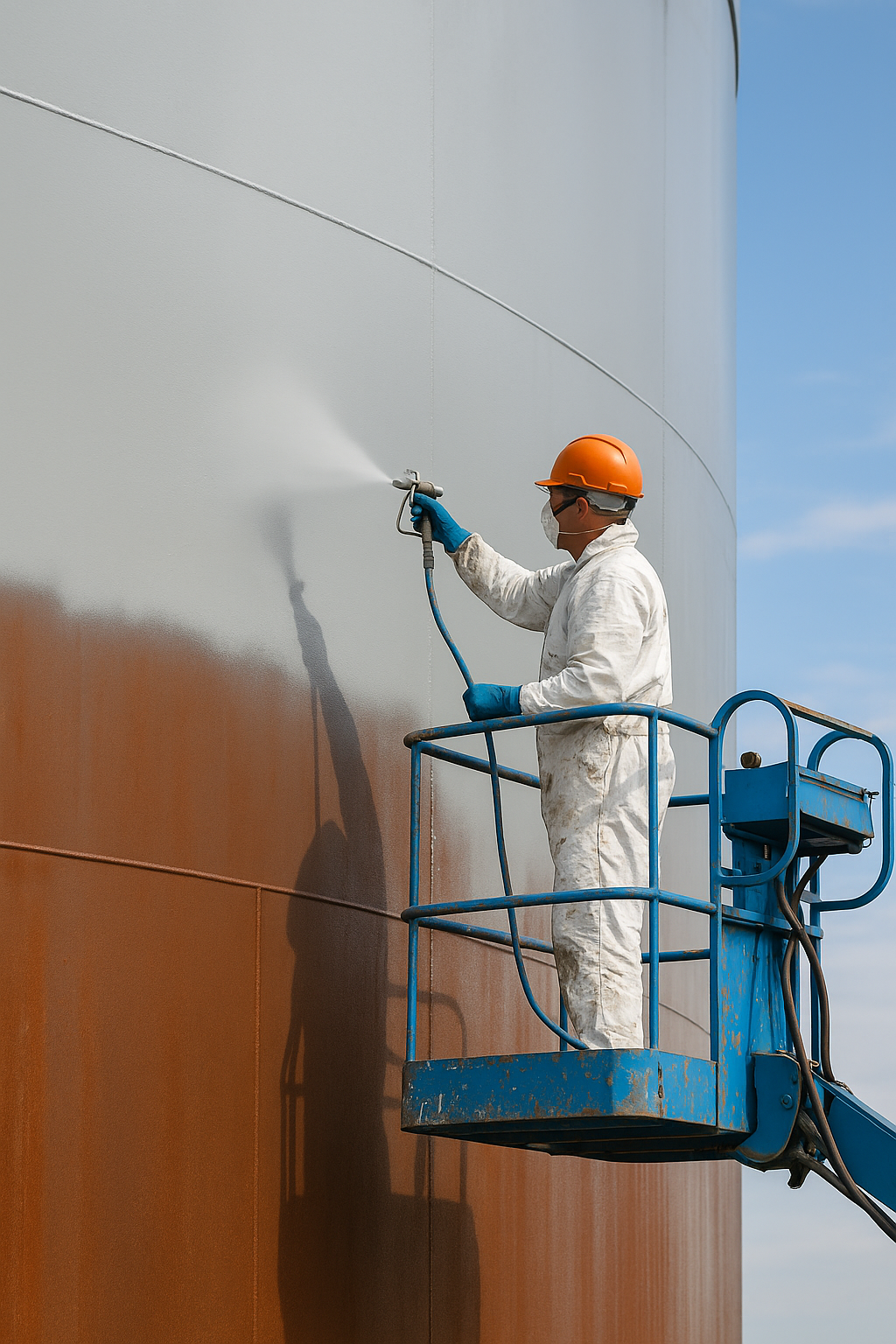Storage tanks are critical assets in industries such as oil & gas, petrochemicals, water treatment, and agriculture. To ensure their long-term performance, safety, and durability, proper tank painting and coating systems are essential. Painting storage tanks is not just about aesthetics—it prevents corrosion, improves service life, and helps comply with industry standards.
In this guide, we’ll cover the full process of painting storage tanks, from surface preparation to final inspection, with practical tips, standards
Why Painting Storage Tanks is Important
- Corrosion Protection → Steel tanks are vulnerable to rust and chemical attack. A protective coating extends service life by decades.
- Regulatory Compliance → API 650, API 653, and OSHA require proper coatings for safety.
- Cost Savings → Preventing corrosion reduces maintenance and replacement costs.
- Operational Safety → Prevents leaks and contamination of stored products.
- Aesthetic & Identification → Tank color coding helps operators and improves site appearance
1. Tank Surface Preparation
Proper surface preparation is the foundation of a successful painting job. Without it, even the best coating system will fail.
Methods of Surface Preparation:
- Degreasing & Cleaning
- Remove oil, grease, and dirt using solvents or detergents.
- Rust & Scale Removal
- Mechanical methods (wire brushing, grinding).
- Sandblasting / abrasive blasting (most effective, Sa 2.5 standard according to ISO 8501).
- Surface Profile
- Achieve anchor profile of 50–75 microns for better coating adhesion.
Example: In oil refineries, tanks are usually blasted with garnet or steel grit to meet SA 2.5 (near white metal).
2. Choosing the Right Paint System
The coating system depends on the service conditions of the tank:
a) External Coating (exposed to weather)
- Primer: Zinc-rich epoxy or inorganic zinc silicate.
- Intermediate Coat: High-build epoxy.
- Top Coat: Polyurethane or polysiloxane (UV-resistant).
b) Internal Coating (in contact with stored product)
- Potable water tanks → Epoxy lining (solvent-free).
- Fuel & chemical tanks → Phenolic epoxy, Novolac epoxy.
- Crude oil tanks → Epoxy with high chemical resistance.
Most projects use a 3-coat system with total dry film thickness (DFT) of 250–350 microns.
3. Application Methods
Common techniques:
- Airless Spray → Fast and uniform, ideal for large tanks.
- Conventional Spray → For smaller touch-up areas.
- Roller/Brush → For stripe coating and edges.
Key Points:
- Apply primer within 4 hours of blasting (to prevent flash rust).
- Follow manufacturer’s recoat window.
- Maintain proper humidity (<85%) and temperature (>10°C) during painting.
4. Safety Measures in Tank Painting
Painting involves hazards (flammable solvents, confined spaces, high pressure spray). Safety measures include:
- Confined Space Entry Permit.
- Ventilation inside tanks.
- Explosion-proof equipment.
- Personal Protective Equipment (PPE) → respirators, coveralls, gloves.
- Fire safety → no sparks or smoking near tanks.
Standards: OSHA 1910, NFPA 30, and API safety guidelines.
5. Quality Control & Inspection
Every painting project requires strict inspection:
- DFT Measurement (dry film thickness) using gauges.
- Holiday Testing for pinholes (internal lining).
- Adhesion Tests (pull-off test).
- Visual Checks for runs, sags, or uneven application.
Example: A fuel storage tank external surface may require a DFT of 300 microns (zinc epoxy + epoxy + polyurethane), confirmed at multiple spots.
6. Painting Large Fuel Storage Tanks (Case Study)
For a 5 million liter tank (API 650, 34 m diameter × 18 m height):
- Surface Area: ~5,200 m².
- Paint System: 3 coats, each 100–120 microns.
- Paint Consumption: ~1.2–1.5 liters per m² per coat.
- Total Paint Needed: ~18,000–20,000 liters.
- Execution Time: 35–45 working days with a 10-man crew.
This example highlights how planning and correct paint selection ensure durability and safety.
7. Maintenance & Repainting
Even with the best coating system, periodic maintenance is required:
- Visual inspections every 6–12 months.
- Touch-up painting of damaged or rusted areas.
- Full repainting after 10–15 years (depending on service conditions).
Pro tip: Keep detailed coating records (paint batch, thickness, inspection reports) for future reference.
Conclusion
Painting storage tanks is more than a cosmetic job—it is a critical protective measure that ensures safe storage, compliance with industry standards, and cost savings in the long run.
By following proper surface preparation, choosing the right coating system, applying with correct methods, and maintaining safety protocols, industries can extend the life of their storage tanks and prevent costly failures.




